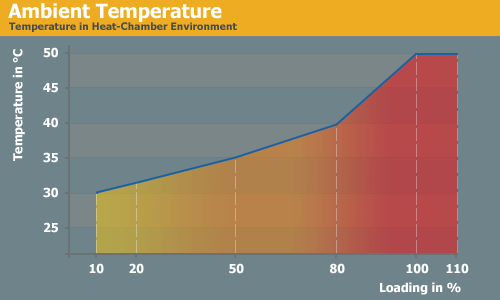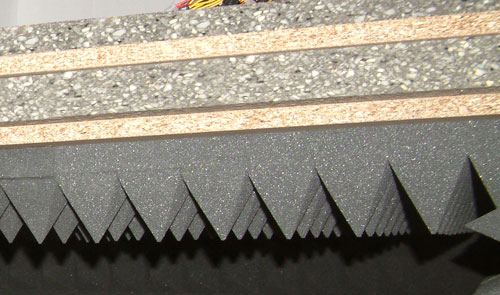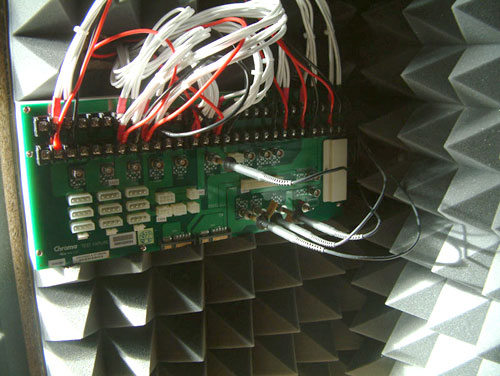Seasonic M12D 850W: DC-to-DC Perfection?
by Christoph Katzer on November 26, 2008 12:00 AM EST- Posted in
- Cases/Cooling/PSUs
Testing with the Chroma ATE Programmable Load

Our test equipment consists of two Chroma programmable DC Loads that enable us to test power supplies with an output of up to 1500W. The biggest advantage of the Chroma DC Loads is simply the high precision it provides. It can measure differences as small as 0.001V and 0.0001A, which will provide us with best-in-class results.
When programming the Chroma with specific amounts of load calculated according to the ATX norm, we are able to load power supplies to an exact percentage. We can now show results at every specific percentage needed. To get the best overview of a power supply, we load each unit with 10%, 20%, 50%, 80%, 100%, and 110% of the specified output. This is easy to calculate for a 1000W power supply: the 10% load is 100W and 110% load is 1100W. Remember that this is the amount of power the PSU delivers; due to inefficiencies, a power supply will actually draw more power from the wall.
Note: If you would like to know more about our testing methodology, equipment, and environment, please read our PSU testing overview.
We have added an additional 10% on the highest load to see how the units perform with overload. This test will be performed in all future reviews. The overload test is performed at room temperature as well as under more stressful conditions; to ensure we are not too cruel to the power supplies, we will keep the ambient temperature at 50°C in the stress test. Experience shows that many units can stand the overload at room temperature but will experience problems with higher temperature and overload together. Only the best-built units will survive this.

The Testing Environment
There is one flaw in testing power supplies with programmable loads while trying to measure the sound pressure levels at the same time. Because the programmable loads get very loud, there is no chance of hearing the power supply on the test stand. In order to make accurate measurements of the noise levels we needed a way to separate the test unit and the programmable loads. Our solution was to build a very thick box around the unit.

We concluded that a five-layer box with a total thickness of 6" (15cm) containing two layers of wood and three layers of special foam would suffice. It is designed as a box within a box. The inner box does not touch any part of the outer box, making it difficult for acoustic noise to pass through in the form of vibration. Each box is isolated on both sides with a layer of heavy foam that is normally used to insulate engines. On the inside we have an additional layer of 4" (10cm) thick pyramidal foam on every side of the box to eliminate the acoustic waves coming from the test object as well as we can.

To ensure a completely closed system we installed the printed circuit board that the connectors of the power supply are attached to inside the anechoic room/box. In other box designs, you would need to put all the cables through the wall. Unfortunately, that would result in the inside of the box not being fully isolated anymore. Our design keeps everything that needs to be connected inside of the box and maintains isolation.










45 Comments
View All Comments
CEO Ballmer - Saturday, November 29, 2008 - link
I have one, works nicely!http://fakesteveballmer.blogspot.com">http://fakesteveballmer.blogspot.com
InterClaw - Friday, November 28, 2008 - link
How much power does the M12D consume while in standby mode (switch on) running on 230Vac?Christoph Katzer - Saturday, November 29, 2008 - link
I will have a small update on that because I did some further testing. The M12D has an incredible high sb-efficiency with up to 76% which is really good compared to 40-ish% of many others.daar - Wednesday, November 26, 2008 - link
Can someone explain the significance for the DC-to-DC configuration over what they or other PSU manufacturers normally do? I mean other than the odd efficiency curves, it doesn't really provide anything unique when compared to say, the Enermax.PrinceGaz - Wednesday, November 26, 2008 - link
I'm guessing here and haven't checked my "facts", but I'm guessing the DC-DC conversion helps because it allows the PSU manufacturer to concentrate most of their effort on providing a clean and efficient +12V rail from the AC supply, then tag the conversion circuitry onto the end of that to generate the less critical +5V and +3.3V rails.The alternative is to have seperate circuitry for generating +12V, +5V, and +3.3V all individually from the AC supply.
JarredWalton - Thursday, November 27, 2008 - link
I believe that's right - it's easier to do 12V DC to 3.3V/5V DC than it is to do 120V/230V AC to the same, so you do one good AC-to-DC conversion and then a couple simpler DC-to-DC conversions.mindless1 - Saturday, November 29, 2008 - link
It's not necessarily easier, it's just that if you first convert to 12V alone you have maximized the amount of 12V current a single transformer of a given size can produce, then let that be the primary feedback voltage to determine switching pulse width. That typically also means you can have higher ratios of 12V to 5V or 3.3V current without going out of spec. It makes more and more sense to do so when a PSU is of high wattage as it's then expected to have so much more 12V current consumption as a % of total power used.Mr Perfect - Wednesday, November 26, 2008 - link
Maybe you could put a bug in Seasonic's ear about their "little" 120mm fan? Looking at the acoustic results, you can't help but wonder what a 140mm fan could have done for that curve. A 140mm might have shifted the whole curve down two or three decibels.piroroadkill - Thursday, November 27, 2008 - link
Bear in mind half of the fan is usually covered towards the front of the PSU, I'm really not sure a 140mm fan helps at all, because that's simply more airflow that's blocked by a baffle. This baffles me (hurr)... Seems like 120mm is perfectly adequete, and more to the point, if you so wish to change the fan yourself, at least 120mm is a standard sizeMr Perfect - Thursday, November 27, 2008 - link
140s are mainly interesting because they produce any given amount of airflow at a lower RPM then 120s. So rather then run it at the same RPM as the 120, and just block more airflow, they could run it at a lower RPM while producing the same airflow. Then maybe it would top out around 28DB instead of a 31DB, or idle at 15db instead of 17. Hopefully there wouldn't be a need to change the fan then.